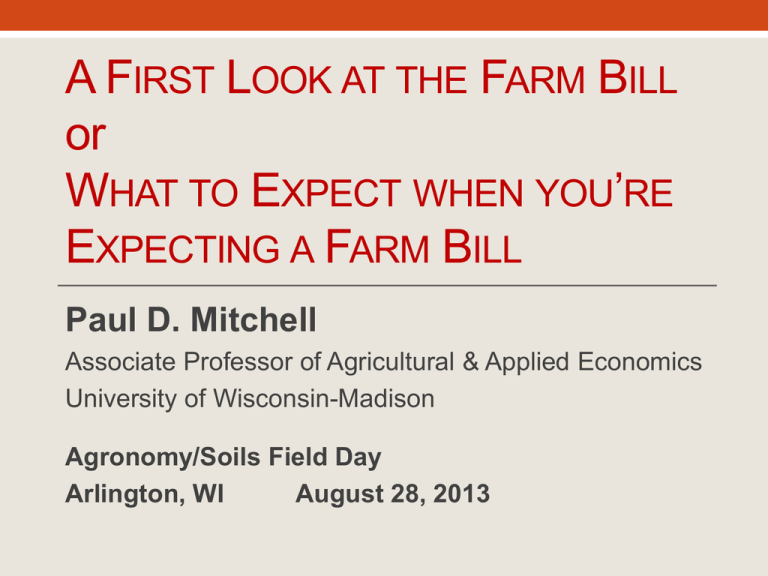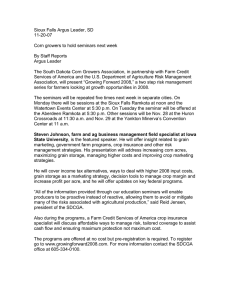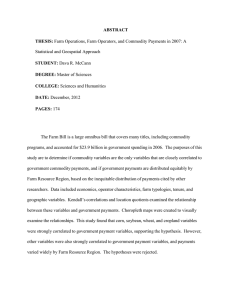What to Expect When You're Expecting a Farm Bill (PowerPoint Aug 2013)
advertisement

A FIRST LOOK AT THE FARM BILL or WHAT TO EXPECT WHEN YOU’RE EXPECTING A FARM BILL Paul D. Mitchell Associate Professor of Agricultural & Applied Economics University of Wisconsin-Madison Agronomy/Soils Field Day Arlington, WI August 28, 2013 Today’s Goal • Overview of existing Farm Programs • How and where we spend about $15 billion/year • Overview of likely changes in programs • 8-10% cut in the $15 billion • Even more emphasis on crop insurance USDA spends about $100$150 billion/year (3%-4%), mix of mandatory & discretionary Most of the USDA budget is for Mandatory Nutrition Programs (SNAP/Food Stamps, WIC, School Lunch Program) All Other 6% 13% 7% 74% Farm and Commodity Programs Conservation & Forestry Nutrition Closer look at the “red slice” Commodity Spending $7 billion $8 billion Source: http://ncseonline.org/NLE/CRSreports/10Oct/R41317.pdf Main Point: Shift to Crop Insurance for Commodity Support Average Annual Outlays Under 2008 Farm Bill Crop Insurance $8.3 bil Risk Management Direct Payments (DP) $4.9 bil (field & specialty crops) Commodity Programs $8.4 bil (field crops) $6.0 bil Non-insured Disaster Assistance (NAP) $0.1 bil Supplemental Revenue Assistance Payments Program (SURE) Ad hoc disaster payments Emergency Assistance for Livestock, Honey Bees, and Farm-Raised Fish Program Farm Safety Net $15 bil Disaster Assistance (crops & livestock) $0.75 bil Source: http://ncseonline.org/NLE/CRSreports/10Oct/R41317.pdf Counter-Cyclical Payments (CCP) $0.559 bil OR Average Crop Revenue Election (ACRE) $0.311 bil Marketing Assistance Loans $0.225 bil Loan Deficiency Payments (LDP) $0.225 bil Livestock Indemnity Program Livestock Forage Disaster Program Tree Assistance Program Emergency Disaster Loans Direct Payments $/ac in 2009 Source: USDA-ERS Farm Program Atlas http://www.ers.usda.gov/data-products/farm-program-atlas/go-to-theatlas.aspx#.UgvP3pLCY6k Counter-Cyclical Payments $/ac in 2009 Source: USDA-ERS Farm Program Atlas http://www.ers.usda.gov/data-products/farm-program-atlas/go-to-theatlas.aspx#.UgvP3pLCY6k Marketing Loan Benefits $/ac in 2009 Source: USDA-ERS Farm Program Atlas http://www.ers.usda.gov/data-products/farm-program-atlas/go-to-theatlas.aspx#.UgvP3pLCY6k ACRE Payments $/ac in 2009 Source: USDA-ERS Farm Program Atlas http://www.ers.usda.gov/data-products/farm-program-atlas/go-to-theatlas.aspx#.UgvP3pLCY6k SURE Disaster Payments $/ac 2009 Source: USDA-ERS Farm Program Atlas http://www.ers.usda.gov/data-products/farm-program-atlas/go-to-theatlas.aspx#.UgvP3pLCY6k MILC Payments 2009 Source: USDA-ERS Farm Program Atlas http://www.ers.usda.gov/data-products/farm-program-atlas/go-to-theatlas.aspx#.UgvP3pLCY6k % Net Cash Income from Govt. Payments not including premium subsidies or indemnities WI Net Farm Income and Govt Pymts ($ Billion, not including premium subsidies or indemnities) 4.50 4.00 3.50 3.00 2.50 Farm Income Govt Pymt 2.00 1.50 1.00 0.50 0.00 1990 1992 1994 1996 1998 2000 2002 2004 2006 2008 2010 2012 Main Point • Roughly $7 billion in commodity support • Direct Payments dominate commodity support spending • Spread all around, but big in the South • Counter-Cyclical Payments: Only in the South • SURE Payments larger in 2009 than in any other year • Commodity payments constitute 40% to 5% of Net Farm Income over the last decade • No disaster program (SURE) for 2012, though crop yields were low, no one asking for disaster program – Why? • Crop insurance took care of the problem! • Let’s take a closer look at where the $8 billion in crop insurance fits into commodity support Crop Insurance Subsidies • Administered by USDA-Risk Management Agency (RMA) • • • • and Federal Crop Insurance Corporation (FCIC) USDA develops policies, rules, and premium rates • Development & administration costs paid by the public USDA subsidizes the premiums • Farmers pay ~35% to 45% of fair premiums on average USDA pays subsidy to companies for Administration and Operating (A&O) ~18%-20% of total premiums FCIC reinsures the insurance companies, plus retains some of the policies • Means FCIC (govt) pays some of the indemnities Crop Insurance Data for 2012 (all units in Millions) Crop Region Corn WI USA Soy WI USA Other WI USA Total WI USA Acres Farmer Liability Premiums 3.04 1,894 81.1 53,421 1.27 499 65.0 25,569 0.88 439 135.7 37,606 5.19 2,833 282 116,596 63.5 1,632 18.9 874 10.8 1,607 93.2 4,113 Premium Subsidies Indemnities 121 2,674 36 1,467 17.9 2,796 175 6,937 397 11,812 37 2,129 16 3,439 450 17,380 • Premium subsidies = $6.9 billion (65% WI, 63% US) • Subsidies to companies $1.3 billion • USDA administration costs = ???, govt indemnities = ??? Crop Insurance Data for 2012 • Corn and Soybeans dominate crop insurance • 50% of the acres, 60% of the subsidies, almost 70% of the liability and 80% of the indemnities in 2012 • Corn and soybeans dominate US crops: corn and soy were 66% of the farm gate value of all US crops in 2011 Region WI USA WI USA Farmer Premium Acres Liability Premiums Subsidies Indemnities 5.2 2,832 93 175 450 282 116,596 4,113 6,937 17,380 Percentage of Total in Corn and Soybeans 83% 84% 88% 90% 96% 52% 68% 61% 60% 80% Main Point • $8 billion direct govt. spending on crop insurance • $6.9 billion premium subsidies + $1.3 billion A&O • Farmers pay $4.1 billion of $11.0 billion total premium • If priced “fairly”, farmers spend $4.1 billion to get $11.0 billion in average indemnities ($2.68 for each $1 spent) • Crop insurance has become the primary mechanism federal govt. uses to support commodity agriculture • Where geographically does that money go? WI vs. Neighboring States % Planted Acres Insured in 2012 State Corn Soybeans IA 94% 91% IL 80% 77% MN 94% 94% MI 70% 70% WI 70% 74% WI historically a low participation state Trends in WI Crop Insurance Participation % of 2009 Crop Acres Insured 2009 Total Payments (DCP, ACRE, LDP, SURE, MILC, CRP, Premium Subsidies) Share of 2009 Total Payments from Crop Insurance Premium Subsidies Average Indemnities Net of Farmer Premiums ($/ac) 2000-2009 Main Point • Crop insurance popular in many regions: • Western Corn Belt, High Plains, Lower Mississippi River Valley, Piedmont • Premium subsidies and net indemnities • Exceed commodity payments in many regions • More significant in “fringe” production areas • Farm Bill proposals and passed versions emphasize crop insurance even more, usually to benefit Midwestern corn and soy farmers more 2013? 2014? 201? Farm Bill • Summer 2012 • Senate passed a Farm Bill • House Ag Committee Passed Farm Bill, but failed • 2013: Senate passed Farm Bill, House passed a Farm Bill without nutrition programs • No conference committee • Same old same old from Congress • Let me know when you get a Farm Bill passed! • Quick summary of 2012/2013 Farm Bills Proposed Commodity Program Changes • Direct Payments: both eliminated • Counter-Cyclical Payments: both eliminated • ACRE Program: both eliminated • Disaster Programs: both eliminated SURE • Keep other programs (LIP, LFP, ELAP, TAP) • Marketing Assistance Loans and Loan Deficiency Payments: both kept and kept same loan rates • Create new Farm Safety Nets with new acronyms Differ on Farm Safety Net • Keep price support like Counter-Cyclical program • New acronyms, basically same program • Create “Shallow Loss” programs for losses not covered by crop insurance • Programs that sit on top of crop insurance and cover part of “farmer deducible” • With a 75% RP policy, farmer “pays” the first 25% of revenue losses below average revenue • Shallow Loss programs pick up part of this deductible (for free) Price Support Programs • 2012: Senate had no price support, House did • 2013: Both had price support • South wants price support • House: Price Loss Coverage (PLC) • Fixed target prices • Planted acres, but limited by historical base acres • Senate: Adverse Market Payments (AMP) • Target prices = 55% of 5 year Olympic average (would be around $2.83/bu for corn in 2014) • Historical base acres Shallow Loss Commodity Support Programs • Senate: Agriculture Risk Coverage (ARC) • House Ag: Revenue Loss Coverage (RLC) • ARC & RLC similar to county-level ACRE program that sits on top of crop insurance • Farmer pays first 11%-15% of losses, ARC/RLC cover up to 10% of additional losses, with any additional losses covered by crop insurance • 75% Revenue Protection is most popular policy Shallow Loss Commodity Support Programs • Differences between ARC and RLC • % losses farmer pays first (11% or 15%) • County revenue or farm revenue for guarantee • Agreements between ARC and RLC • Only cover an additional 10% of losses, greater losses covered by crop insurance • Use 5-year Olympic average of yields & prices • Not farm yields or futures prices • Meant to help with multi-year losses/trends, not short-term annual losses like crop insurance Supplemental Coverage Option (SCO) • Part of 2012 and 2013 Farm Bills, additional shallow loss coverage farmers can buy • If covering 11% to 15% of losses is too much, choose Supplemental Coverage Option (SCO) • Buy a GRIP county revenue policy for the part of the RP crop insurance deductible not covered by ARC/RLC • SCO sits on top of individual crop insurance coverage and layered with ARC/RLC Proposed Cuts ($ Billion per Year) Senate House Ag Nutrition Crop Insurance Commodity Programs Crop Insurance + Commodity -$0.4 +$0.50 -$1.94 -$1.44 -$1.6 +$0.95 -$2.36 -$1.41 Conservation Total -$0.64 -$2.31 -$0.61 -$3.51 • Senate and House Ag essentially the same • Debate was about how much to cut nutrition programs and how to support commodity ag • Both emphasize crop insurance even more -9% ~-33% Main Point • The structure of commodity support will change, but the overall level will be about the same • Overall spending reductions for commodity support are modest, around 9% • Eliminate DCP, ACRE, and SURE disaster program to create new Price Support and Shallow Loss Programs • Crop insurance set to become the foundation of commodity support with increased emphasis • Commodity support programs will sit on top of crop insurance or be layered with it Other Likely Changes to Expect • Reduced Insurance Premium Subsidies: the new fiscal and political reality • A small % for everyone and/or pay much higher % of premiums if exceed AGI limit • Tighten payment limits • Greater use crop insurance as a policy tool for non-risk management purposes • Conservation Compliance for crop insurance • Will need non-ag votes to pass Farm Bill Conservation Programs • Farm Bill proposals cut CRP by about 1/3 • More emphasis on crop insurance, less on farm programs, and cuts to CRP and low CRP re-enrollment • Concern about lower incentives for program sign up, so farmers may not participate as much • No more carrot/stick to follow Conservation Compliance • Growing concerns about soil erosion, wetlands, environment, etc. as we have expanded cropped acres • Conservation Compliance restrictions for crop insurance free to government, a zero budget way to get urban votes Conservation Reserve Program Payments 2009 ($1.87 billion in 2009, $1.75 billion in 2012) % 2011 CRP acres expiring 2012 % 2011 CRP acres expiring 2012-2014 Dairy Program • Current passed House and Senate versions replace Dairy program with a subsidized gross margin insurance • LGM Dairy policy, but with premium subsidy • Insure margin between milk price and feed prices • Senate has supply control, House does not • Not my area, see • Dr. Mark Stephenson, UW’s CDP: http://dairy.wisc.edu/ • Dr. Brian Gould, UW AAE: http://future.aae.wisc.edu/ Farm Bill Expectations: My Thoughts • 3 Scenarios seem possible for the Farm Bill 1. Pass a separate Farm Bill 2. Pass Farm Bill as part of fiscal reform/budget bill 3. Pass another extension of the 2008 Farm Bill • Price expectations are lower, tighter margins for crops • $7 corn has hidden a lot of management problems • The Party is Over! Time to get back to work • My Advice: Don’t count on the government • Crop insurance will continue, but don’t be dependent on government support payments to be profitable • Take care of your farm business, be a good efficient farmer to maintain profits with tighter margins Conclusion • We spend about $15 billion a year in government • • • • • payments to farmers ($375-$775 million to WI farmers) • More than half is for crop insurance at US level • A little less than half in WI is for crop insurance New Farm Bill, if it ever passes, will likely cut spending about 9% and put even more emphasis on crop insurance Price support option will stay about the same New shallow loss programs will sit on top of crop insurance or be layered with it Subsidy limits or AGI limits for crop insurance? Conservation compliance for crop insurance? Thanks for Your Attention! Questions? Paul D. Mitchell Agricultural and Applied Economics University of Wisconsin, Madison, WI pdmitchell@wisc.edu 608-265-6514 http://www.aae.wisc.edu/pdmitchell/extension.htm Follow me on Twitter: @mitchelluw

